
The Bell of Death is a 1939 mystery detective novel by Anthony Gilbert, the pen name of British writer Lucy Beatrice Malleson. It is the sixth in her long-running series featuring the unscrupulous London lawyer and detective Arthur Crook. It was published during the Golden Age of Detective Fiction. Reviewing it for the Times Literary Supplement, Maurice Percy Ashley commented "as usual with Mr. Gilbert’s stories this is exciting and well written, but it is so complicated that the reader can do little more than hold his breath".

The Man Who Wasn't There is a 1937 mystery detective novel by Anthony Gilbert, the pen name of British writer Lucy Beatrice Malleson. It is the second in her long-running series featuring the unscrupulous London solicitor and detective Arthur Crook.

Murder Has No Tongue is a 1937 mystery detective novel by Anthony Gilbert, the pen name of British writer Lucy Beatrice Malleson. It is the third in her long-running series featuring the unscrupulous London solicitor and detective Arthur Crook.
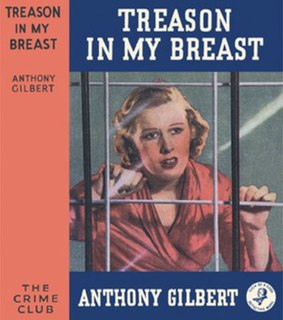
Treason in My Breast is a 1938 mystery detective novel by Anthony Gilbert, the pen name of British writer Lucy Beatrice Malleson. It is the fourth in her long-running series featuring the unscrupulous London solicitor and detective Arthur Crook. Crook became one of the established characters of the Golden Age of Detective Fiction, although in this case the novel was more similar to a Victorian melodrama than a conventional whodunnit.
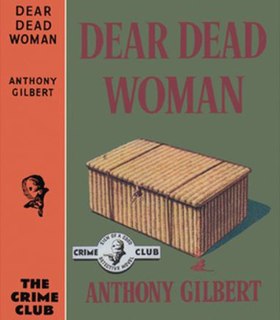
Dear Dead Woman is a 1940 mystery detective novel by Anthony Gilbert, the pen name of British writer Lucy Beatrice Malleson. It is the seventh in her long-running series featuring the unscrupulous London solicitor and detective Arthur Crook. In 1942 it was published in America under the alternative title Death Takes a Redhead.
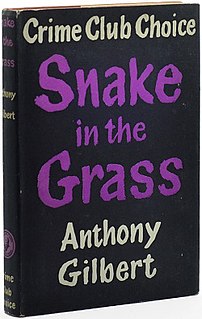
Snake in the Grass is a 1954 mystery detective novel by Anthony Gilbert, the pen name of British writer Lucy Beatrice Malleson. It is the twenty eighth in her long-running series featuring the unscrupulous solicitor and detective Arthur Crook. It was published in the United States under the alternative title Death Won't Wait. Reviewing it in the New York Times Anthony Boucher described it "one of Gilbert’s duller books", while other reviews were more praiseworthy.
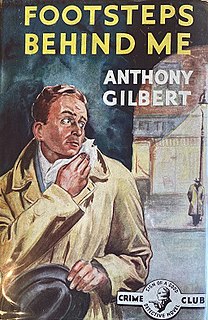
Footsteps Behind Me is a 1953 mystery detective novel by Anthony Gilbert, the pen name of British writer Lucy Beatrice Malleson. It is the twenty seventh in her long-running series featuring the unscrupulous solicitor and detective Arthur Crook. Crook first appeared during the Golden Age of Detective Fiction, but the series ran for several decades. It was published in the United States under the alternative title Black Death.

The Musical Comedy Crime is a 1933 mystery detective novel by Anthony Gilbert, the pen name of British writer Lucy Beatrice Malleson. It is the seventh entry of the series featuring Scott Egerton, her principal character before her better known creation Arthur Crook appeared three years later. A traditional whodunnit, it was published during the Golden Age of Detective Fiction.
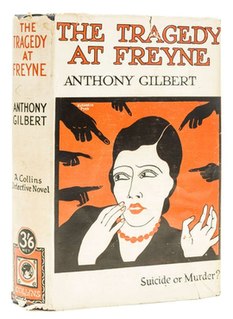
The Tragedy at Freyne is a 1927 mystery detective novel by Anthony Gilbert, the pen name of British writer Lucy Beatrice Malleson. Her first novel under the pseudonym, it introduced the amateur detective Scott Egerton who was her principle character until the creation of Arthur Crook in Murder by Experts.

The Night of the Fog is a 1930 mystery detective novel by Anthony Gilbert, the pen name of British writer Lucy Beatrice Malleson. It is the fifth of ten novels in a series featuring her amateur detective and politician Scott Egerton, a precursor to her better known creation Arthur Crook.

The Body on the Beam is a 1932 mystery detective novel by Anthony Gilbert, the pen name of British writer Lucy Beatrice Malleson. It is the sixth of ten novels in a series featuring her amateur detective and politician Scott Egerton, a precursor to her better known creation Arthur Crook.

The Man Who Was Too Clever is a 1935 mystery detective novel by Anthony Gilbert, the pen name of British writer Lucy Beatrice Malleson. It is the tenth and last in a series of novels featuring her amateur detective and politician Scott Egerton. The following year she introduced a new character, the unscrupulous solicitor Arthur Crook, in Murder by Experts.

The Vanishing Corpse is a 1941 mystery thriller novel by Anthony Gilbert, the pen name of British writer Lucy Beatrice Malleson. It is the eighth in her long-running series featuring the unscrupulous London solicitor Arthur Crook, one of the more unorthodox detectives of the Golden Age. It was published in the United States under the alternative title She Vanished in the Dawn.

Lady Killer is a 1951 mystery thriller novel by Anthony Gilbert, the pen name of British writer Lucy Beatrice Malleson. It is the twenty fifth in her long-running series featuring the unscrupulous London solicitor Arthur Crook, one of the more unorthodox detectives of the Golden Age.
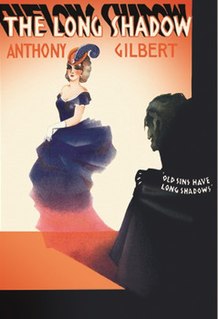
The Long Shadow is a 1932 mystery detective novel by Anthony Gilbert, the pen name of British writer Lucy Beatrice Malleson. It is the seventh of ten novels in a series featuring her amateur detective and politician Scott Egerton, a precursor to her better known creation Arthur Crook.

Murder Comes Home is a 1950 mystery thriller novel by Anthony Gilbert, the pen name of British writer Lucy Beatrice Malleson. It is the twenty third in her long-running series featuring the unscrupulous London solicitor Arthur Crook, one of the more unorthodox detectives of the Golden Age.

Miss Pinnegar Disappears is a 1952 mystery detective novel by Anthony Gilbert, the pen name of British writer Lucy Beatrice Malleson. It is the twenty sixth in her long-running series featuring the unscrupulous solicitor and detective Arthur Crook. Crook first appeared during the Golden Age of Detective Fiction, but the series ran for several decades. It was published in the United States under the alternative title A Case for Mr. Crook.
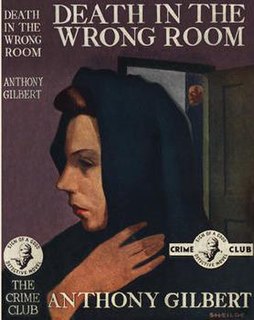
Death in the Wrong Room is a 1947 mystery thriller novel by Anthony Gilbert, the pen name of British writer Lucy Beatrice Malleson. It is the nineteenth in her long-running series featuring the unscrupulous London solicitor Arthur Crook, one of the more unorthodox detectives of the Golden Age.
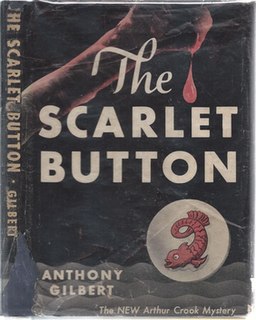
The Scarlet Button is a 1944 mystery thriller novel by Anthony Gilbert, the pen name of British writer Lucy Beatrice Malleson. It is the fourteenth in her series featuring the London solicitor Arthur Crook, one of the more unscrupulous detectives of the Golden Age. It was published in the United States, initially under the same name and later with the alternative title Murder is Cheap.

The Woman in Red is a 1941 mystery thriller novel by Anthony Gilbert, the pen name of British writer Lucy Beatrice Malleson. It is the ninth in her series featuring the London solicitor Arthur Crook, one of the more unscrupulous characters of the Golden Age of Detective Fiction. It was first published by the Collins Crime Club.




















